This is a compilation of the designer diary entries posted in the Rolling Realms Facebook group. They are listed here in chronological order, with the most recent entry at the top.
***
October 3: Tales from Production
August 13: The Dice, Rulebooks, and Media
Today brings the final design diary for Rolling Realms! Usually this is when I say exactly when the preorder will begin, but that date is dependent on exactly when the final freight shipments arrive out our fulfillment centers in the US, UK, Australia, and Canada–it’s looking like late September. You can sign up for a preorder launch notification here.
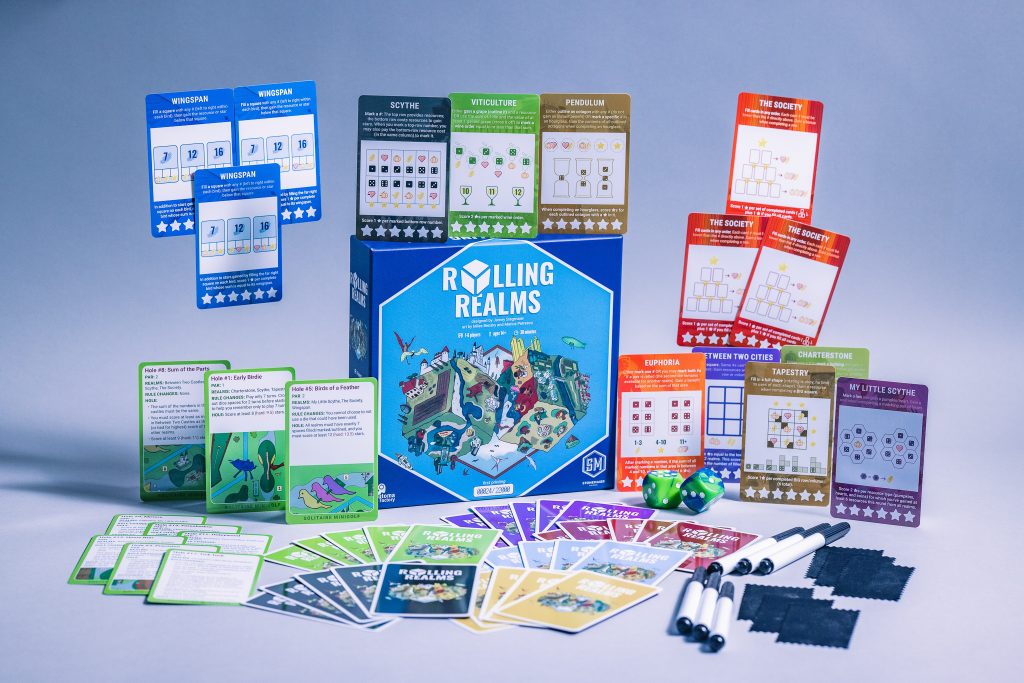
On a video in the first design diary, I showed the evolution of the dice in Rolling Realms, but I thought I might share a photo of how they changed over time. The started 16mm d6 dice in the foreground are just for reference. We started with 40mm resin dice as shown in the background, but they were so heavy that they didn’t roll well (and they sound like they’re breaking the table). So we switched to smaller resin dice, but they were still too heavy. We ended up going with swirled acrylic dice (25mm) with hexagonal pips. I’m really happy with how they roll, and they’re still big enough to show up well on camera if you’re playing remotely.
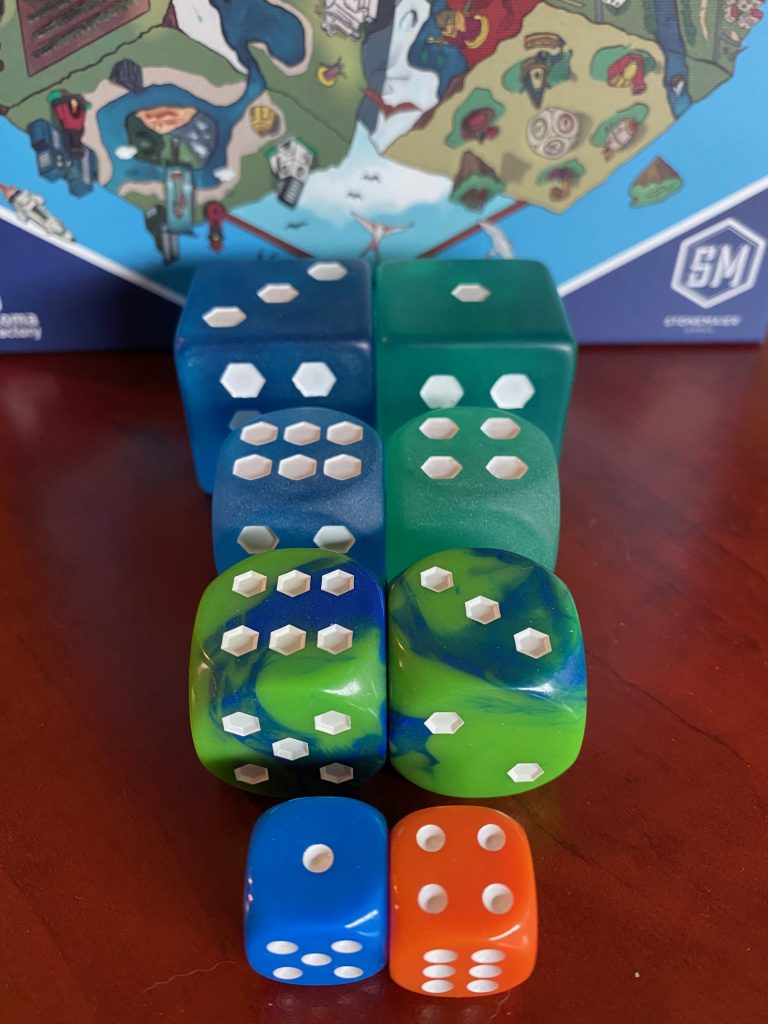
I’ve now uploaded both the core and Automa (solo) rulebooks to Dropbox; you can preview or download them here.
Finally, as we typically do with new games, we commissioned Rodney at Watch It Played to create a how-to-play video for Rolling Realms. This may be particularly helpful when you’re actually sitting down to play the game, as you could skip to the corresponding segment for the realms you select for each round.
More media will follow in the coming days (compiled here), including reviews next week.
Thank you for joining me on this design diary journey, and if you have questions about anything I missed, I’m happy to answer them in the comments below!
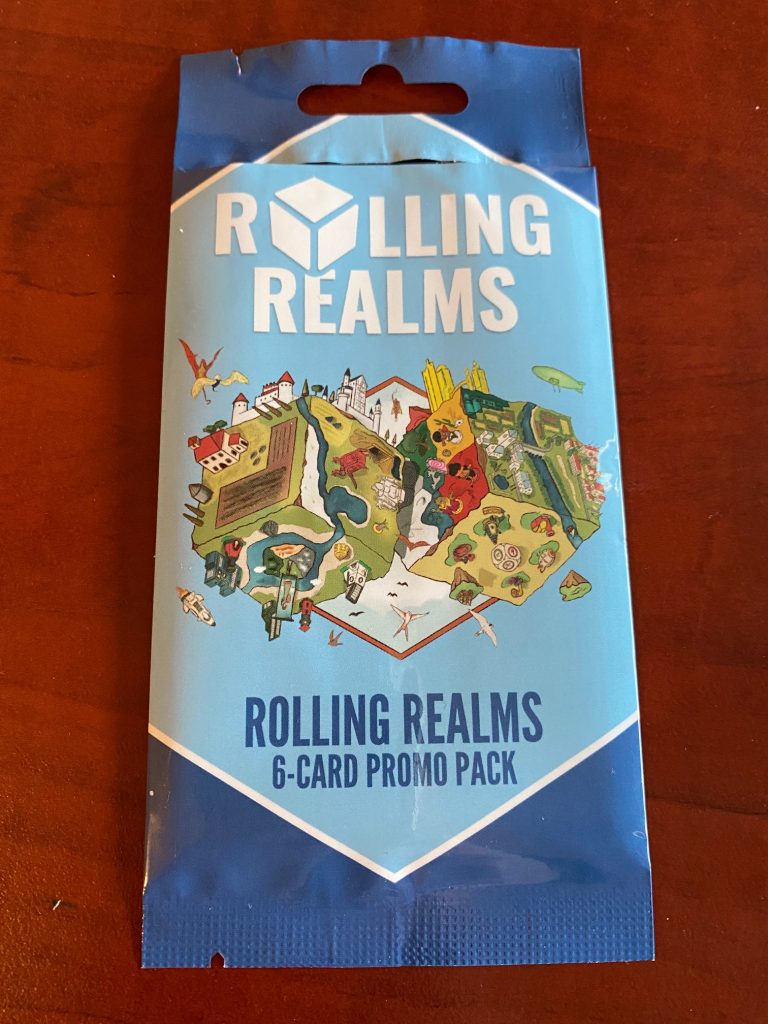
August 12: The Future, Realm Selection, and Teaser Trailer
A number of people have asked about the future of Rolling Realms, specifically: If each realm is based on a different Stonemaier game, what about games released in the future? Will there be a Rolling Realms realm for Rolling Realms?
We’ve been pondering this question for a while, and here’s the plan: Whenever we’re gearing up to publish a new game, I’m going to design corresponding realm for that game. We’ll package it as a promo, and we’ll offer it to you in some way (perhaps for free with a preorder of the new game, then later as an add-on purchase; we might also offer them at conventions). As with all of our promos, as long as there’s demand for them, we’ll continue to make each pack–there’s no fear of missing out on a one-time print run.
With this in mind, we do indeed have a promo pack containing a Rolling Realms realm for Rolling Realms. It won’t be ready at the same time as the core game, so we’ll offer it on our webstore later, probably during the Tapestry expansion preorder later this year:
In a typical game of Rolling Realms, one player will randomly select the 3 realms to be used in the current round. One of our shareholders, Ryan, also had the clever idea of offering a realm-selection web app as an alternative way of selection a realm. It’s now available here.
I’ll save the final rulebook reveal for tomorrow, because today is the debut of the Rolling Realms teaser trailer! Big thanks to Joe for creating the storyboard, JC Trombley for making the video itself, Megan Selke for the wonderful voiceover work, and the talented Joel Winbigler for composing the music.
August 11: Teaching 3 Realms at a Time, Plus Tapestry, Pendulum, and Red Rising
In a full game of Rolling Realms, you play 3 rounds, and in each round all players have the same 3 randomly determined realms. For example, in the first round you might have Viticulture, Scythe, and Charterstone; the second round you might have Euphoria, Between Two Castles, and Wingspan, and in the third round you might have Tapestry, The Society, and Pendulum.
I stumbled upon this structure very early in the design of the game, and it offered something that instantly resonated with me: Because only the current 3 realms are relevant, you don’t need to explain how all 11 realms work before the game begins. You just explain the basics–which are also noted on the score card–randomly select the 3 realms, and teach how those realms work.
To make the teach even easier, the rules for the realms are printed on each card. There’s no need to memorize a series of icons and symbols–if you forget how a realm works, just read the card! :)
To demonstrate this, today I’ll teach the final 3 realms:
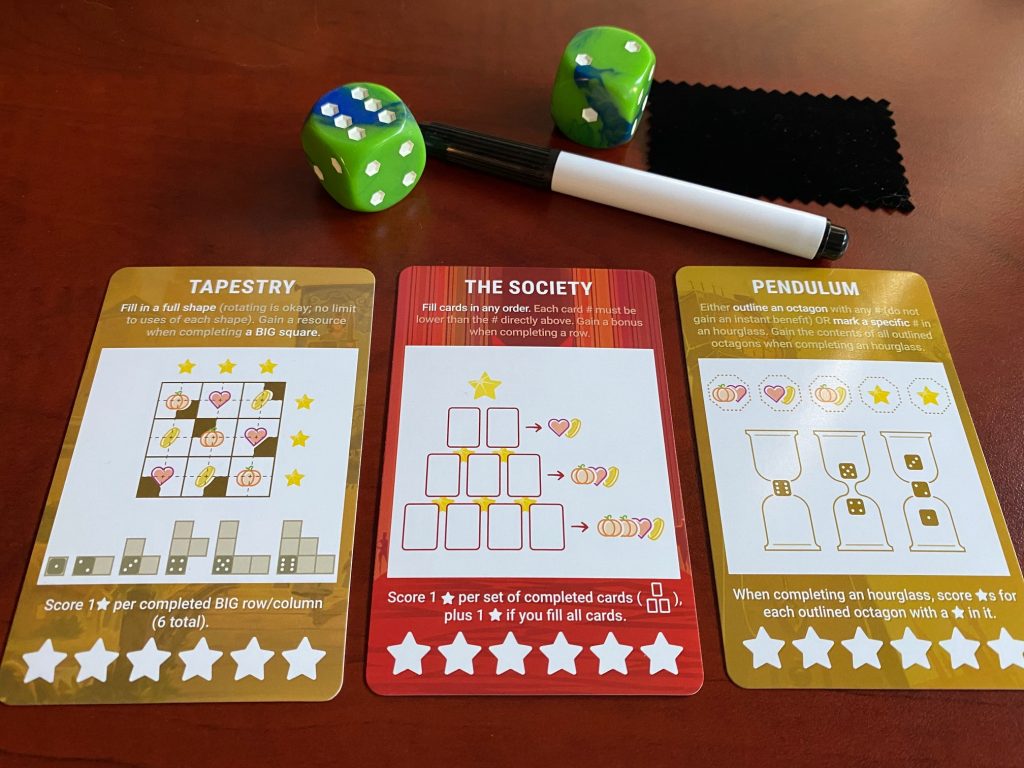
Tapestry: I love polyomino puzzle, just like the capital cities in Tapestry. Depending on the die, you’ll fill in a shape within the grid. If you complete a big square, gain the resource you covered. For each big row or column that’s completely filled in, gain 1 star.
The Society: This Red Rising-inspired realm features a pyramid like the one found in the titular Society. You can write a number on any “card,” but each number much be lower than the number directly above it (kind of the opposite of Between Two Castles). If you complete a row, gain the corresponding resources. If you complete a set of 3 cards, gain a star. And if you complete the entire pyramid, gain the star indicated at the top.
Pendulum: Here I tried to showcase the engine building and time optimization in Pendulum. You can either use any number to outline an octagon or you can use a specific number to mark the corresponding hourglass. Whenever you complete an hourglass, you’ll gain the contents of all outlined octagons.
Tomorrow I’ll show you the teaser trailer and talk about the future! For now, remember to sign up for a launch notification for the preorder in September. For every person who requests a preorder launch notification on this form in August 2021, Stonemaier Games will donate $1 to the International Tree Foundation to restore woodlands, conserve habitats, and help communities that rely on forests.
August 10: Dry-Erase Markers, Cards, Erasers; also Castles and Wingspan
When I decided to use dry-erase cards for Rolling Realms, I looked for examples of great dry-erase markers in other games. It was then that I realized something: I’ve never been fully satisfied with a tabletop game dry-erase marker.
Every marker I’ve seen has either been too small, short, or wide to hold comfortably with a tip that’s too wide and mushy and a top that doesn’t close tight or grip to the end of the marker.
So we set out to find the best dry-erase markers, and while you’ll be the final judge, I’m really happy with what we found. They’re 12 cm long, 1 cm wide, and the tip is fine but strong. The cap grips tight but not so tight that you need a vise to pry it off (as was the case with one version we tested).
The only sacrifice we had to make to keep this marker was that there wasn’t a version that included the eraser on the cap itself. As a result, we’ve included 6 eraser pads.
Also, during this process Joe keenly noticed that the cards only had the special dry-erase coating the front (you don’t write on the back). He recommended that we foolproof the cards by coating both sides, so if you accidentally mark the back side, it’ll wipe clean just like the front.
Today’s first realm is Between Two Castles. I really like the castle shapes Marius created for this realm–much better than my original prototype!
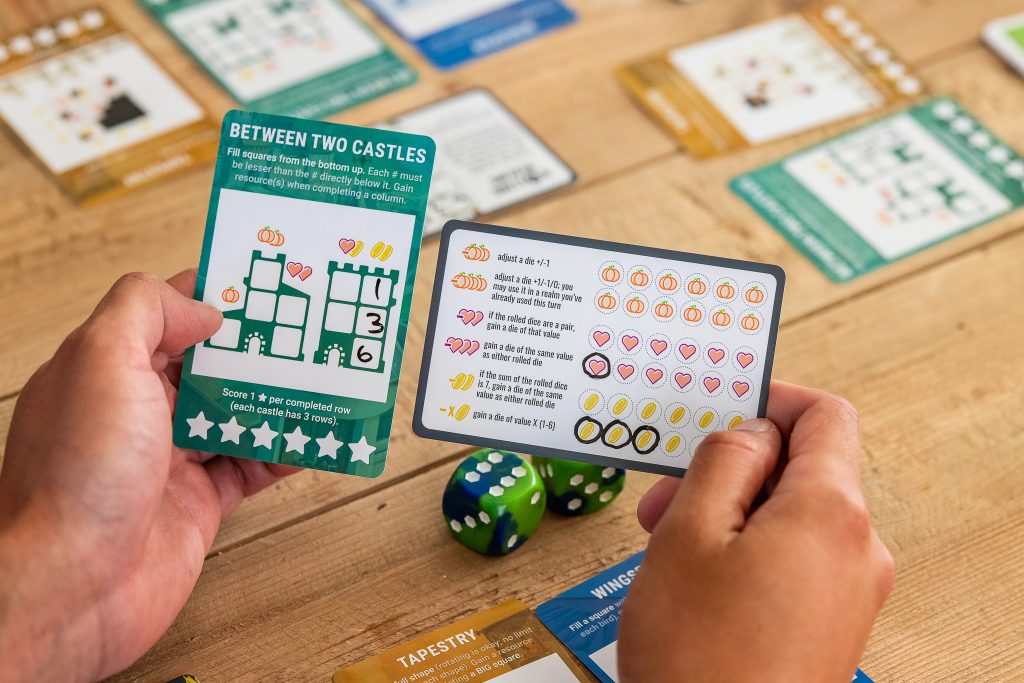
In the Castles realm, you’re trying to build 2 castles from the bottom up. To do so, each number must be lesser than the number directly below it. When you complete a column, you gain the reward at the top. At the end of the game, you’ll score 1 star for each completed row in each castle.
This design worked well from the beginning, and I think I only made small changes to the resource rewards during development.
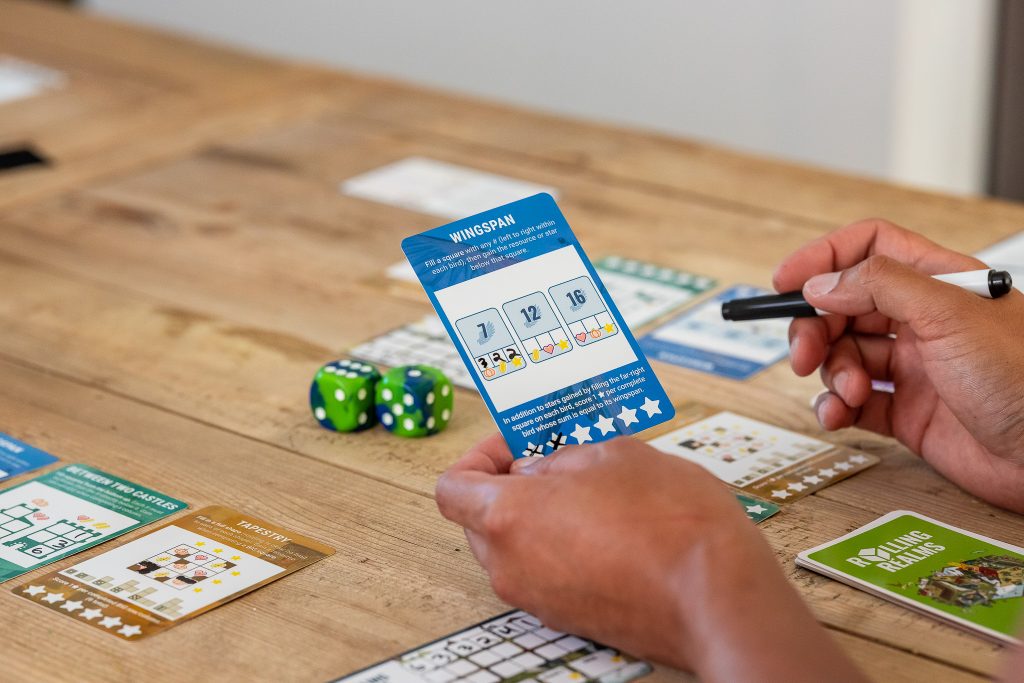
Wingspan is another realm that worked well early in the design process. Within each “bird card” on the realm, you must write numbers from left to right (so, you could start with the middle bird, but left to right on that bird), gaining the resource below the number you write.
The final space on each bird has a star. When you write that number, thus completing the bird, if the numbers you’ve written on that bird add up to the number on that bird (7, 12, or 16), you gain an additional star. Originally the rightmost star was a resource, but I liked the idea of rewarding players for completing birds even if the math didn’t quite work out.
Thanks again to Tim Chuon for all of these nice photos! We have a few more design diary posts before the rulebook and Watch It Played reveal. Is there anything else you’re hoping I talk about before the end of these posts?
August 9: Automa Solo Mode and My Little Scythe
Automa Factory leader and solo game aficionado Morten Monrad Pedersen joins us for part 1 of a post that will continue on BoardGameGeek! I’ll rejoin you at the end of this post to show you the My Little Scythe realm.
[Morten] I knew it was a gamble when I set out to create a solo mode that turned one of my core design tenets on its head, but it seemed like the best and most interesting option.When my team and I make solo modes, we make artificial opponents called Automas that mimic player interactions and do as little else as possible. Therefore, the fewer interactions a game has, the easier it is to make an Automa.
So, a game like Rolling Realms where there’s no player interaction should be as easy as it gets to make an Automa for, right?
Wrong.
Well, it is easy, if your target audience likes to be bored because without interaction an Automa becomes a complicated and time-consuming way to generate a semi-random number of points for the player to compete against.
With that realization it was clear that I had to come up with another approach for the solo mode.
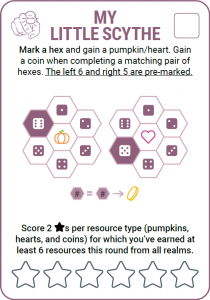 SO, WHAT NOW?
SO, WHAT NOW?
One way to fix the problem would be to add player interaction but that would be a huge change to a game that’s non-interactive by design, so I didn’t want to do that.
If adding interactions wasn’t an option, then the only way of involving the player would be to have them make decisions on behalf of the bot and this is the core tenet violation I mentioned above.
When I play a solo game, I want to avoid making decisions on behalf of a bot because it takes me out of the play experience to have to play in opposition to myself and I start to feel like I’m both players. This removes the game’s tension because for me I feel no excitement in finding out whether Morten or Morten wins.
It occurred to me that this issue could be circumvented if you make all decisions for the bot and must make the worst decisions you can. All of a sudden, you aren’t forced to make decisions against your own best interest because you make decisions for the bot based on what is best for you.
Since a bot like this violates one of my core tenets it can’t be called an Automa, so another name was needed. My wife suggested Metoma (as in the word “me”) because the player would make decisions on behalf of the bot. The name later got changed to Youtoma to be consistent with our rulebooks which are written in 2nd person and to sound more like Automa.
Now that the bot had a name we needed to decide on its gender. Our Automas are female, but we couldn’t have Youtoma be a woman because that would mean that there’d male players controlling a female character to make her play as stupidly as possible. Therefore, we decided that Youtoma didn’t have a specified gender.
PLAYING BADLY
I’ve never seen a solo mode like Youtoma (please let me know in the comments if you have), so from a professional perspective the idea was intriguing, but players might not like the idea of trying to play badly. Thus, it was clear that I was making a gamble. If I were to make such an experiment, though, Rolling Realms would be the right game because the game is solo playable without any changes. So, if the experiment failed, we could fall back to playing the game as normal with no opponents.
Since Rolling Realms on average rewards skillful play, it was clear that unless it’s Opposite Day you will score more points when you try to maximize the score than when you try to minimize it and therefore, you’d almost always beat Youtoma. So, I set to work tweaking the Youtoma part of the game to provide a challenge.
At this point my codesigners, Karel Titeca and Lieve Teugels joined the team and we set to work tweaking the Youtoma part of the game to provide a challenge.
We enjoyed playing Youtoma and the first several playtesters who joined the project also liked it. The project that had started out as a risky experiment seemed like a success.
KILLING YOUTOMA
As we added more playtesters the tide turned and many of the new playtesters weren’t fond of Youtoma. Either the whole concept seemed so unappealing that they didn’t want to play it, or their feedback ranged from dislike to OK.
Almost half of the total number of playtesters fell in those two categories and therefore I made the decision that Youtoma had to be killed.
It was a tough decision that sent a few hundred hours of work down the drain but as mentioned I knew from the beginning that it was a gamble and it was the right decision, because selling a solo mode that only half the playtesters like well isn’t acceptable for us.
In part 2 of this post, I’ll leave Youtoma behind and talk about the solo mode we made instead.
[JAMEY]Next in chronological order is the My Little Scythe realm, which plays around with the idea of hexes, fruit, and friendship.
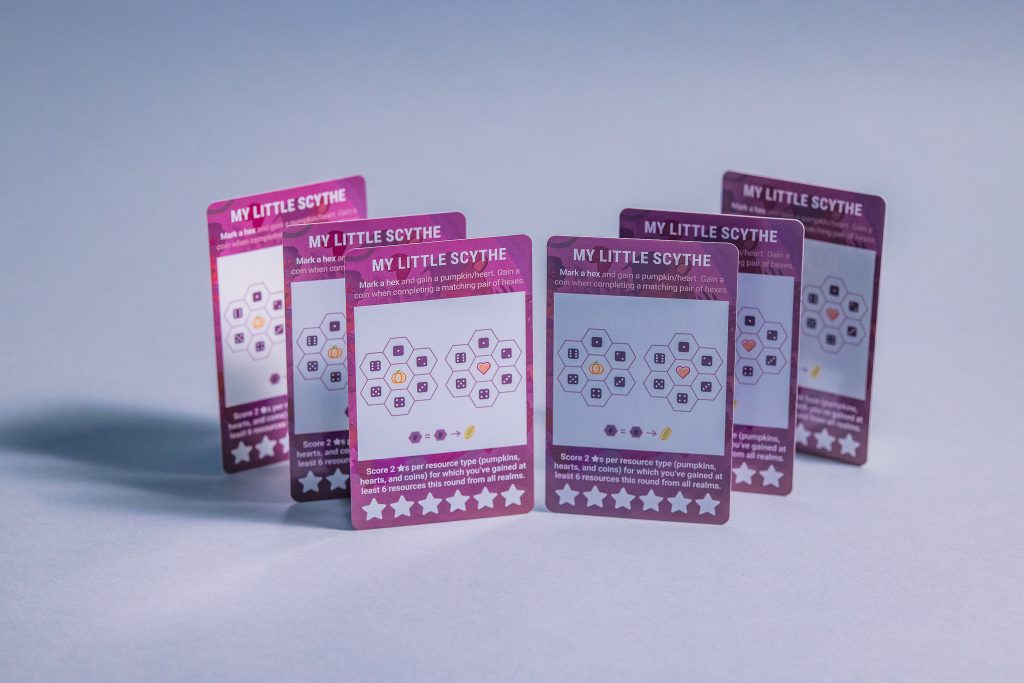
In this realm, you’ll mark a hex and gain either a pumpkin or a heart. You’ll also gain a coin when completing a matching pair of hexes (e.g., if I’ve already marked the 5 pumpkin and I mark the 5 heart, I’ll then also gain a coin).
For scoring, you’ll look at resources you gained that round in any way (not just from My Little Scythe). It doesn’t matter if you’ve spent those resources or not–all that matters is that you gained them. For each type of resource for which you’ve gained at least 6 this round, you’ll earn 2 stars in the My Little Scythe realm.
Now you can head over to BoardGameGeek for the reveal of what Morten figured out for Automa!
August 8: Resources, Stars, and Charterstone
Very early on in the design process for Rolling Realms, I decided that I wanted players to earn something other than points during the game. My hope was that by creating a basic resource system in the game, players would face interesting decisions each round: Do I gain resources now that will lead to more points later, or just grab points whenever I can?
I also wanted 3 resources that are found in multiple Stonemaier game. Coins were easy, as they’re in many of our games. Hearts–the concept of popularity/morale–are found in Scythe, My Little Scythe, and Euphoria. And several of our games have some concept of fruit (grapes, apples, etc), so I picked pumpkins (from Charterstone).
Whenever you gain a resource in Rolling Realms (each realm has a different way to earn resources), you simply circle it on your resource card, where it waits until you’re ready to use it. To spend resources you’ve gained, just cross them off and gain benefits like adjusting the number on a die you’re using or even gain an extra number to use. At the end of each round, excess resources are worth 0.1 star each (a change requested during the Facebook Live playtests), then your entire resource card is wiped clean for the next round.
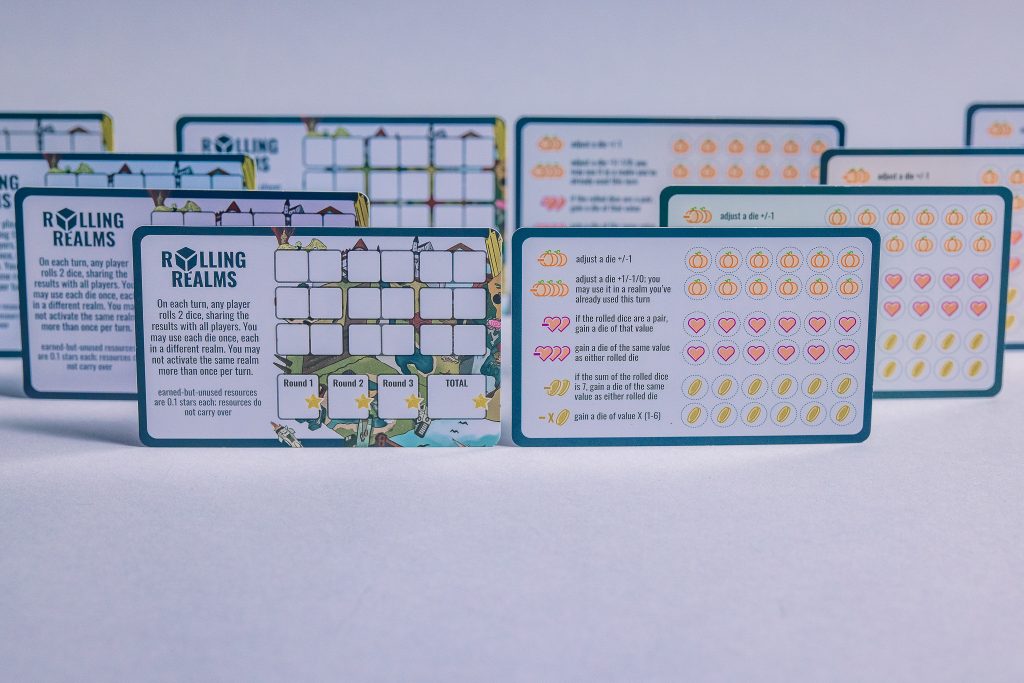
The motivation for using stars as points is similarly rooted in our games. How many of our games feature stars? (answer in the comments below)
At the end of each round, you’ll count up the number of stars earned that round and note it on your score card (adding 0.1 stars for each earned-but-unused resource–even though the decimal is a bit clunky, I thought it would be more clunky to add a points-conversion system. Stars = points is simpler). The score card also features 9 paired spaces to write the dice rolled that round in case you want to look back before the end of the round (when it’s wiped clean).
I’ll close today with the Charterstone realm! I really wanted to capture the core idea from Charterstone that you’re constructing buildings and then opening a crate for each building.
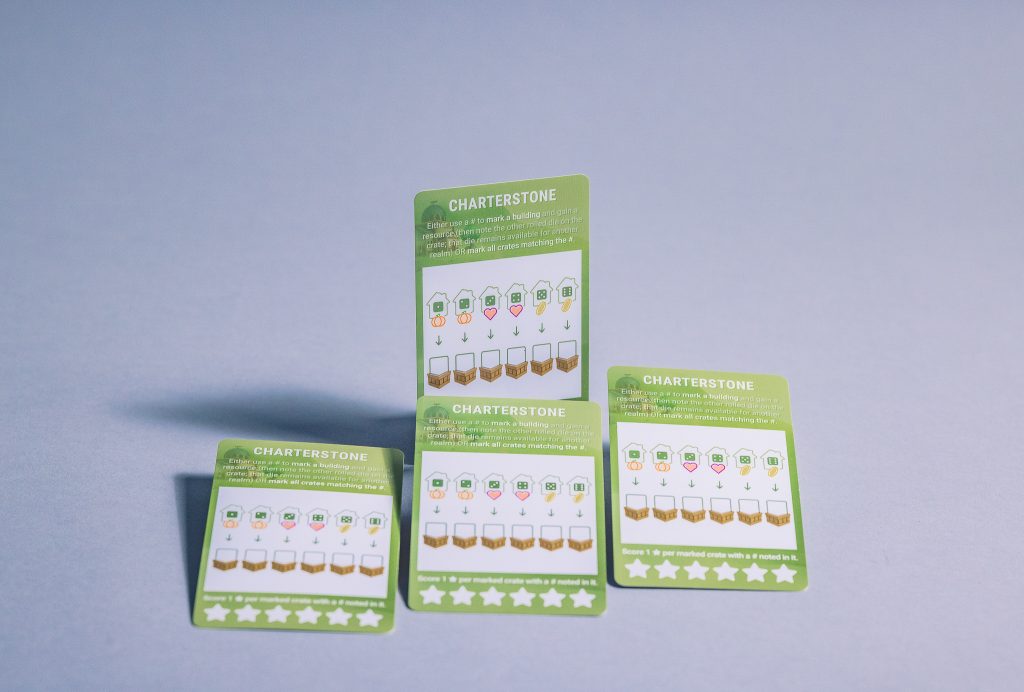
Early in the game, you’ll mark off numbers on the buildings in Charterstone to gain a resource. When you do that, you’ll note the number on the other die on the crate below the building. So, if a 5 and a 2 are rolled, you might use the 5 to cross off the fifth building and gain a coin, then write “2” on the crate below it. You haven’t actually used the 2, though–you’ll use it in another realm that turn.
Later in the game (any time after you have a number on a crate), you can use a die to mark ALL crates matching that number. So if you’ve noted “2” on several crates, you can later use a 2 die to cross of all crates with “2” at the same time, earning a star for each. It can be very satisfying to earn multiple stars with a single number if you plan well.
I’ll be back tomorrow with more information! For now, what is your guess of how many of the 12 Stonemaier games use stars in some form?
August 7: Player Interaction, Player Count, and Scythe
I’ll come right out and say it: There is no player interaction in Rolling Realms. You cannot impact what other players do, and other than comparing methods at the end of each round, there’s no reason to pay attention to other players.
This is by design. I designed Rolling Realms early in the pandemic for infinitely scaling remote play. The final version still has that goal in mind, though it’s also intended to be played around the table.
I have to admit that I wasn’t always excited about roll-and-write games, but then I played On Tour and something clicked. On Tour is just like Rolling Realms in that there’s no player interaction at all. But that actually makes the game super accessible at various player counts, and it flows well because everyone is writing down the numbers simultaneously.
Basically, for the right game, I believe that a lack of player interaction can actually be an asset. When I play disc golf, I don’t want to wrestle other players to get to my disc–I just want to focus on my strategy, yet I still have more fun with other players present when I play. Same with Rolling Realms (though I will discuss the solo mode soon).
Despite the benefits of an being infinitely scaling, when we print a game, there are some necessary limitations for what we include in the box. Especially after I chose to use large dry erase cards. I looked at data we had from demographic surveys and various cost/price points, and eventually I decided to make Rolling Realms a 1-6 player game out of the box: 6 sets of cards, 6 dry-erase markers, and 6 erasers.
Of course, you can still play Rolling Realms with more players if you have more than one copy or if you play remotely with anyone who has the game (or even just a set of the cards included in the game).
I’ll close today with a reveal of the Scythe realm, which is exciting for me because we’re currently celebrating Scythe’s 5th anniversary in the Scythe Facebook group (its retail release was August 10, 2016). Here’s the Scythe realm:
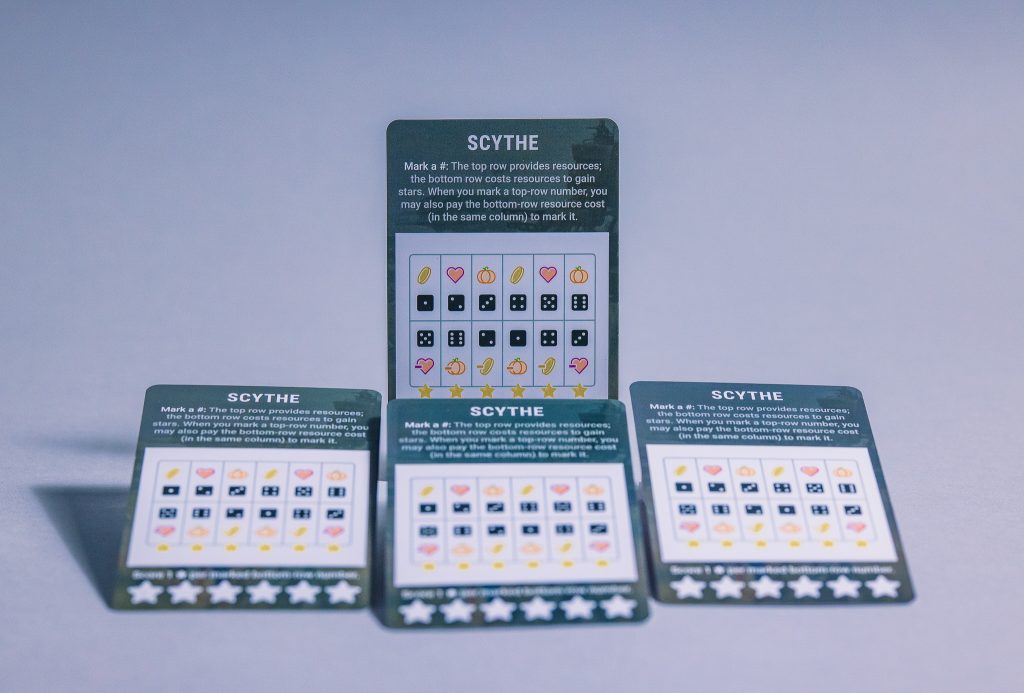
The original Scythe game has a lot of different mechanisms, so it was one of the more difficult realms to figure out. In the end, I decided to lean into the idea of top- and bottom-row actions.
In this realm, you’ll mark a number matching a die in either the top row (which gives you a resource) or the bottom row (which gives you a star but costs you a resource). As a thematic twist, when you mark a top-row number, if you’re able to pay the corresponding bottom-row resource cost, you can also mark it off to gain the star that way.
So if you time it correctly, you may only need 6 dice to complete the Scythe realm.
Have a great Saturday, and I’ll be back tomorrow with more information! What’s your favorite low-interaction game?
August 6: The Artists, More Playtesting, Euphoria, and Between Two Cities
While I was wrapping up the last few Facebook Live playtests for Rolling Realms last year, a few things happened.
First, friend and Red Rising artist Miles Bensky voluntarily made an image for the game “box” (even though it was just a one-sheet print-and-play at that point). I really liked how Miles combined Easter Eggs from all of our games into the art and that it looked like two dice-shaped worlds side by side. When it later came time to create the actual box art, I commissioned Miles to touch up the whimsical art to what you see on the final version:
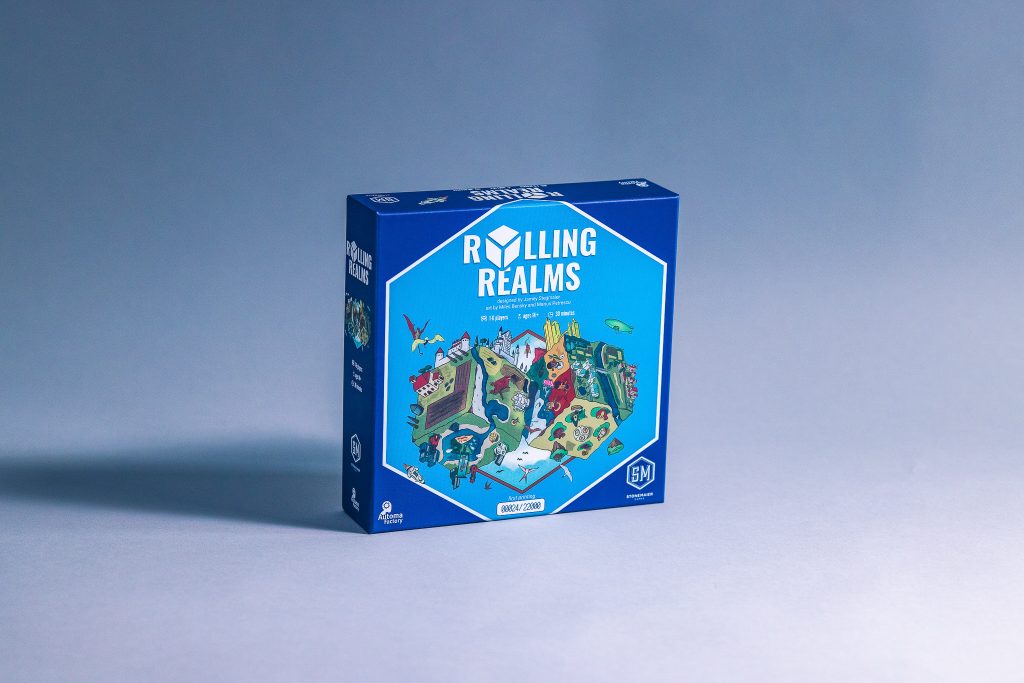
Second, another newer artist, Marius Petrescu, voluntarily created much more polished versions of each of the realms and posted them on BoardGameGeek. At the time I was trying to determine the balance between art and graphic design on the realms, as I didn’t want the art to distract or confuse from the puzzle on each realm, and I thought Marius captured it perfectly. So I reached out to Marius and commissioned him to work on the art for all realms.
Third, even though thousands of sessions of Rolling Realms had been played by that point, I still put it through our regular blind playtest process just to make sure I wasn’t missing anything (plus, our blind playtesters are awesome). Not much needed to change on the realms themselves, but up until that point all of the rules existed only on the realms themselves–a big part of blind playtesting is ensuring the rules are comprehensive and clear.
That brings us to the two realms I’d like to feature today, Euphoria and Between Two Cities.
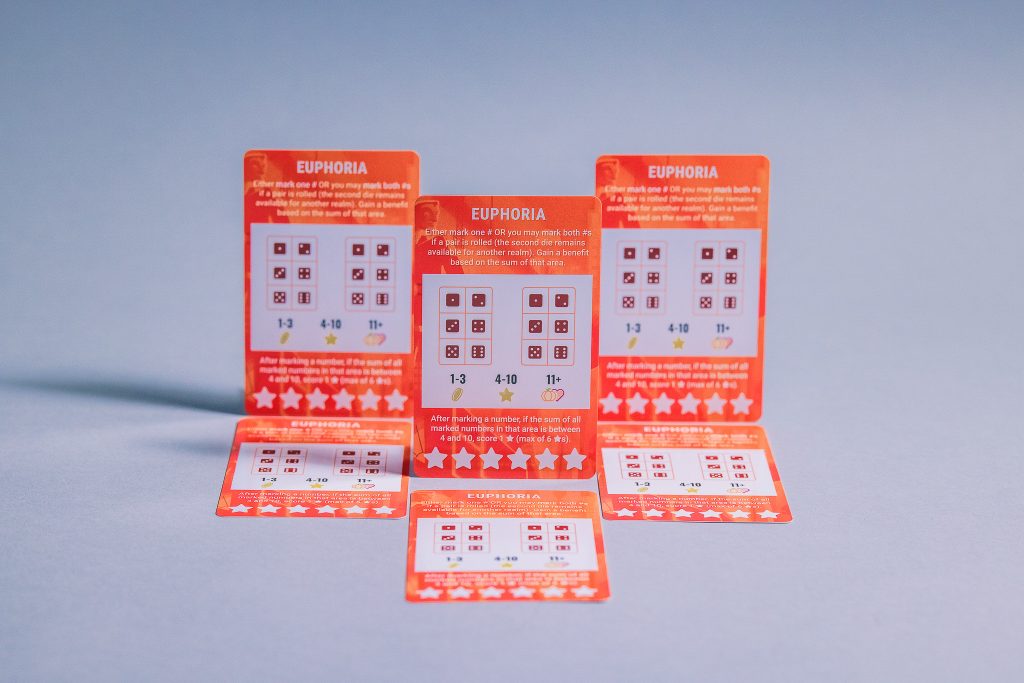
In the Euphoria realm, I tried to capture the concept of the commodity areas and the value of rolling pairs in the Euphoria game. You’ll either mark 1 number or both numbers if a pair is rolled (though you still get to use one of those numbers in another realm), then gain the benefit based on the sum of the area.
For example, if I’ve already marked a 1 and 3 in the leftmost area and a 4 is rolled, I could mark it off and then add 1+3+4 (8 total). The benefit for any area sum from 4 to 10 is a star, so I would gain a star.
I think one of the later changes to this realm was giving players both a pumpkin and a heart for a sum of 11+ to make it more lucrative, as well as adding a reminder about how stars are gained at the bottom of the card for consistency with other cards.
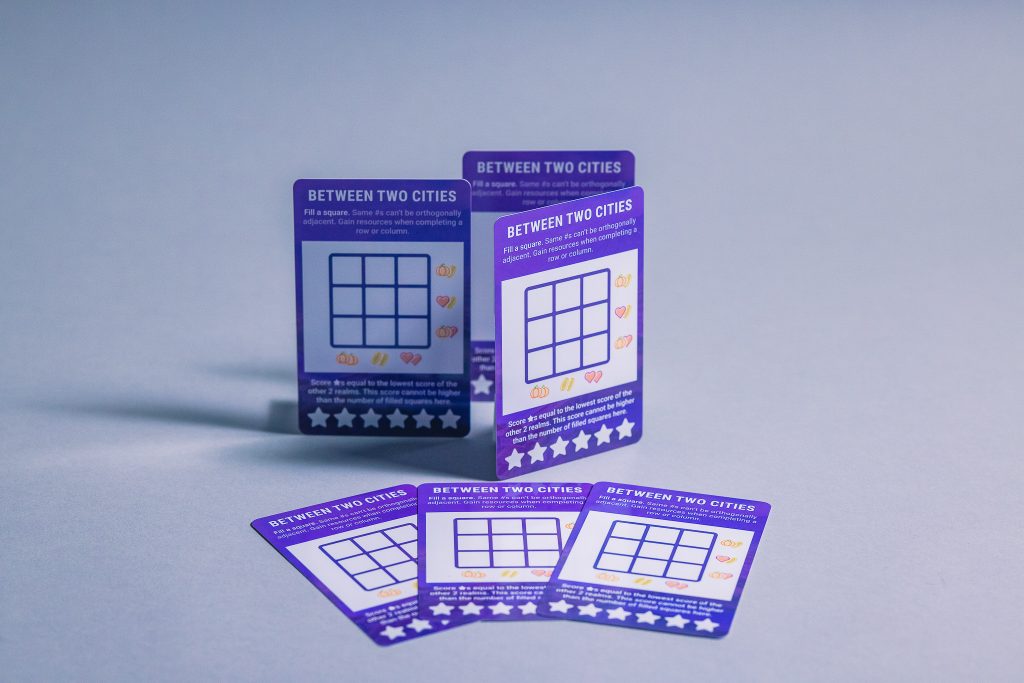
The inspiration for the Between Two Cities realm comes from the stringent grid requirements of the original game, captured in a 3×3 grid here instead of a 4×4 grid. When you write a number in one of the nine squares, you can’t write it next to the same number. Whenever you complete a row or column, you gain the resources for that column.
A meta B2C twist here is that you don’t actually earn any stars from this realm. Instead, you’ll score stars equal to the lowest score of the other 2 realms (at any given time in the game, you’ll be working on 3 realms. To ensure you don’t just ignore the Between Two Cities realm, its score cannot be higher than the number of filled squares in this realm (that was probably the last change made here).
Let me know if you have any questions so far, and I’ll be back tomorrow with more details!
August 5: Origin Story, Core Gameplay, and Viticulture
Remember the first few months of the pandemic? It was a time of fear and uncertainty–we didn’t know how the virus spread, there weren’t vaccines available, and the world shut down. The streets of St. Louis were eerily quiet.
Not knowing how long this period of self-isolation would last, I sat down on a Saturday afternoon and started designing an infinitely scaling roll-and-write game, something that could be played remotely to connect with Stonemaier fans around the world.
On March 24, I hopped on Facebook Live to play the first version of the game, and I was surprised and delighted by the number of people who joined me. The camera stayed on my dice, as the dice in Rolling Realms are used by all players, and I explained how each realm worked when it became relevant. People asked questions, shared their scores, and pointed out things that did or didn’t work well.
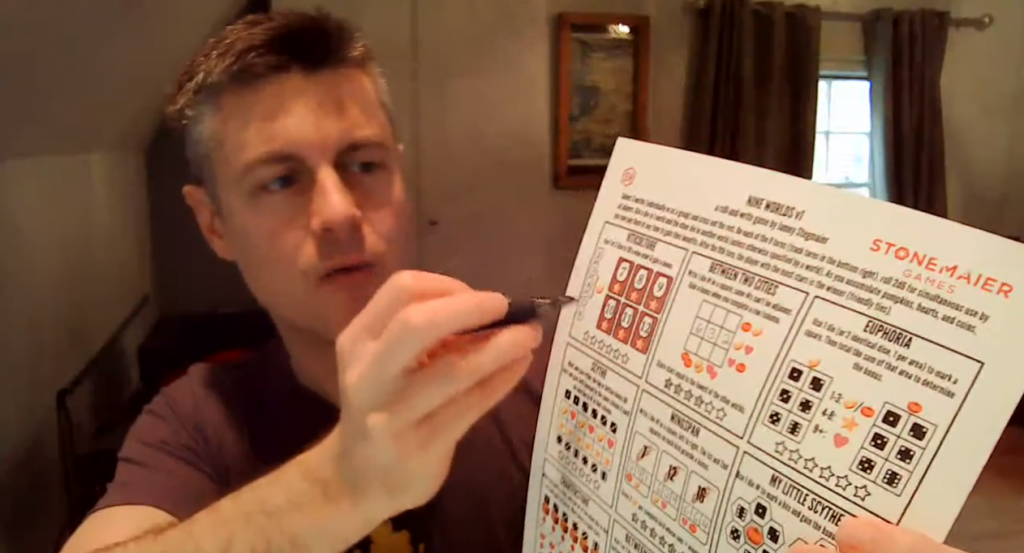
Over the next month or so, I reiterated and played Rolling Realms this way nearly a dozen times. All of the videos are still on YouTube. I’ll never forget the camaraderie and fellowship of those games, and I’ve heard from many people that it has a positive impact on them during a difficult time. That was the entire reason I designed Rolling Realms–I wasn’t creating it for the purpose of publishing it.
But as the game reached its 9th and 10th versions, aided significantly by all the feedback from the Facebook livesteams, I realized that it had actually evolved into something that had a place on the tabletop beyond just a single-sheet print-and-play. Sure, it is less of an event game like other Stonemaier brands, but it was fun, and it did something our other games don’t do: It can be played with anyone in the world (who has a copy or a set of realm cards) with ease.
You see, the way Rolling Realms works is that each player has the same random set of 3 realms (per round, played over 3 rounds). Any player rolls the dice (which we made big enough–25mm–to easily be seen on camera if you’re playing remotely), and each player uses one of the dice in one of their realms and the other die in a different realm. You’re trying to earn stars via the puzzle of each realm, and you’re able to spend and collect resources along the way.
Inspired by the game Silver & Gold, the final game uses dry-erase cards as the realms. They’re big, sturdy cards (65x100mm) illustrated graphically by Marius Petrescu. The other option would have been a big pad of paper, but the use of cards ensures that you’re only ever looking at 3 realms at a time. They’re also easy to randomize, easier to expand, and you’ll never run out of sheets this way.
I have more stories to share in upcoming design diaries, as well as the final version of each realm card. The design of each realm is inspired by a different Stonemaier Games, so I’ll introduce them in chronological order starting with Viticulture.
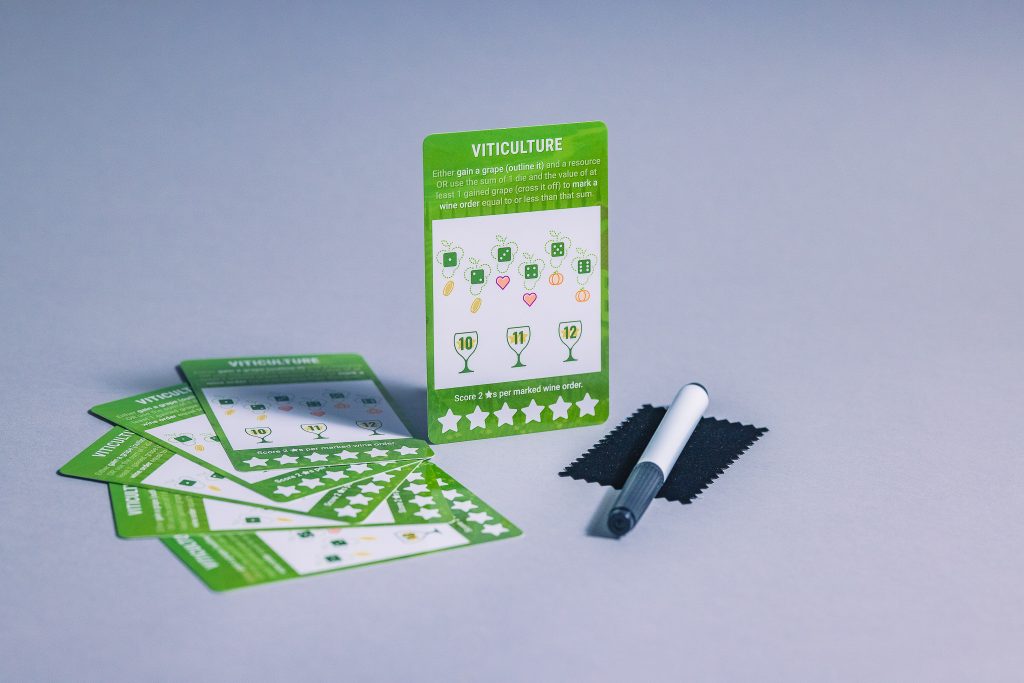
In the Viticulture realm, you can either use a specific number to gain a grape (circle it on the card) and gain the resource below it OR you can use the sum of 1 die and the value of at least 1 gained grape to mark a wine order equal to or less than the sum.
So, early in the game if the number 5 is rolled, I might circle the number 5 grape and gain a pumpkin resource (I’ll explain them in a future post). Later in the game if another 5 is rolled, I might use it and cross off the 5 grape to add those numbers together and complete the 10-value wine order, gaining 2 stars (stars are how you win).
Thanks for joining me for today’s design diary post, and I’ll be back tomorrow with more information and more realms! Also, big thanks to professional photographer Tim Chuon for this photo and all nice photos you’ll see in upcoming posts.
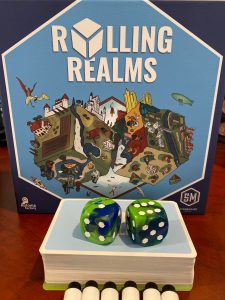
August 4: Facebook Live, Dice, Preorder, and Launch Signups
Most design diaries will be written, but for this first day, below is a video of my Facebook livecast in which I answered a number of questions about Rolling Realms.
Here’s a quick recap of things I discuss in the video:
- I talk about the smaller box size and the price (the exact amount I haven’t shared yet, but I stressed the affordability of the game).
- I mentioned that the game plays 1-6 players out of the box using large dry-erase cards. The game is infinitely scalable, so you can buy multiple copies to play with more than 6 players (or if you intend to play with fewer than 6 players, you could mail realm cards to friends/family so they can play with you online). The final game will not be available to print and play.
- I went through multiple versions of the dice, starting with resin 40mm dice and ending up with the 25mm dice shown here.
- Every first-run copy of the game is individually numbered, with 22,000 units in the first print run.
- We don’t yet know the exact day for the preorder, as freight shipping is very slow right now and we want to make sure all fulfillment centers have the game before we start asking you to pay for it. We’re hopefully looking at late September for the preorder.
- In the meantime, you can sign up for a launch notification. For each person who does this in August, we will donate $1 to the International Tree Foundation.
- I will be hosting online liveplays of the game as soon as we deliver preorder copies.
I think those are the major elements I covered in the livestream! I look forward to sharing more tomorrow.
19 Comments on “Design Diary”
Leave a CommentCancel reply
If you ask a question about a specific card or ability, please type the exact text in your comment to help facilitate a speedy and precise answer.
Your comment may take a few minutes to publish. Antagonistic, rude, or degrading comments will be removed. Thank you.
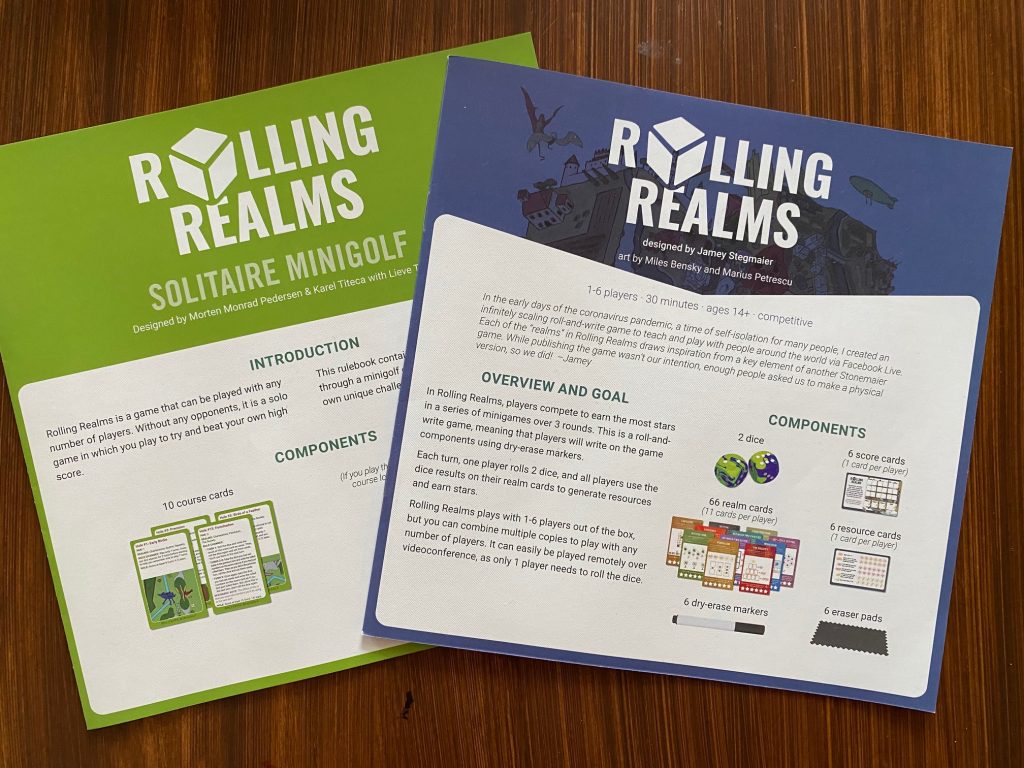
Watch It Played video sold me on this game! It’ll be my first ever “Roll & Write” type of game, if that is what you call them. And I think I will even venture out and try others as well.
Thanks for coming out with more awesome games!
Awesome, thanks Cami! Here’s a list of some of my favorite roll-and-write games: https://youtu.be/FBh7oXbU0Q8
Thanks for the link! Looking into a few of those now. So, maybe Rolling Realms won’t technically be the “first” in my collection after-all. It’ll probably end up being the 3rd depending on when that pre-order opens ;)
Soo looking forward to this game release!
When our son was born we brought Harvest Dice to the hospital. Hoping we can bring Rolling Realms this time.
Jamey, this is a very exciting game to “follow” through development. I played the V3 or V4 of the print and play last spring with my family (and even introduced it to some friends online) during the Pandemic and am thrilled to see it returning in table top form. It genuinely helped break up the long days inside during lockdown, and I know it will bring life to our game nights here in late 2021.
Loved it back then and am excited to see the game retain much of its former self. Also looking forward to experimenting with the minor tweaks that will surely change some realms for the better. Can’t wait to get it!
Also, shocked to see Morten involved in what I thought could be a solo-ish version in and of itself…but the final theme and score card for the solo experience now has me itching to try it out. Kudo’s to the team. Keep up the great work, as always – top notch.
Thanks Joshua! It means a lot to hear that, and I hope the final version can help in these continued times of careful human contact. I’m also really impressed what Morten (and artist Miles) created in the solo version!
Wait, so what exactly is in the rolling realms promo? I think you answered for Ross that it is not a Rolling Realms realm, but that’s how I read it.
So very excited for this game, when talking to my friends someone asked, “What are you most excited for?” I said quality dry erase markers. I said I knew they would be because its Stonemaier games! And here we are during the reveal and you are blowing expectations out of the water! I cannot wait to play it with you online after the games have shipped out.
p.s. I was hoping for a realm included of a game not yet released as I thought that would be a crazy cool thing to do, but that has not lowered my excitement for this game!
It’s a new realm–6 cards (1 per player) inspired by the Rolling Realms game (just as, say, there’s a realm inspired by Charterstone).
Excellent! That is super exciting! Will that realm be revealed soon before it can be purchased?
We’ll reveal it when it’s available for purchase. :)
Very clever that you future-proofed the Red Rising card against potential loss of IP down the road. That’s such a smart move, to prevent issues with future printings of Rolling Realms.
I actually didn’t even think of that. The reason I didn’t use the Red Rising name is that I don’t think Pierce’s lawyers would have understood that this wasn’t actually a Red Rising game, just a meta reference to it. :)
Is there going to be a very meta Rolling Realms realm in the game?
Ross: As mentioned in today’s design diary post, there are 11 realms in Rolling Realms, so there is not a Rolling Realms realm included in the game.
I’m hoping you talk about possible plans to include new realms as new Stonemaier games are released. 6 realm cards in every new game, a promo pack with the new realm released alongside new games, or maybe an annual expansion pack of new realms including any released games from the previous year?
Thanks! We do indeed have a plan for that, and I’ll discuss it this week. :)
So glad to hear! I’m excited for this game. What a great year for Stonemaier, Red Rising & now Rolling Realms!!!
Where do I go to sign up for the launch notification?
Right here! https://stonemaiergames.us1.list-manage.com/subscribe?u=09ac14cf4204b623f977b3476&id=e5283efdcf